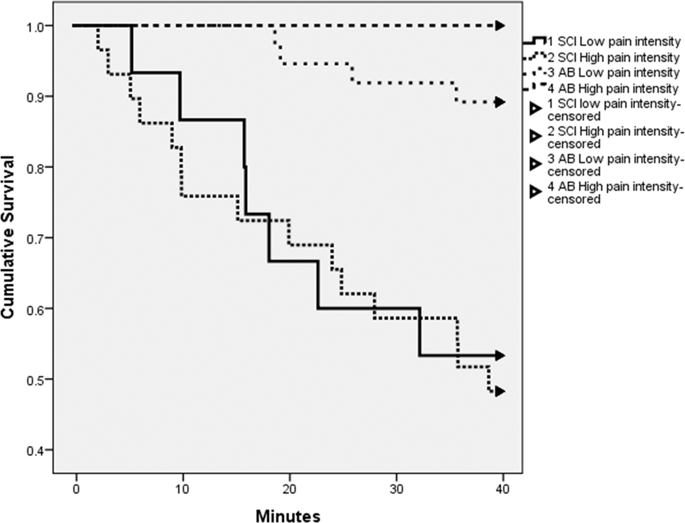当前位置:
X-MOL 学术
›
Spinal Cord
›
论文详情
Our official English website, www.x-mol.net, welcomes your
feedback! (Note: you will need to create a separate account there.)
Excessive daytime sleepiness in adults with spinal cord injury and associations with pain catastrophizing and pain intensity.
Spinal Cord ( IF 2.1 ) Pub Date : 2020-01-30 , DOI: 10.1038/s41393-020-0425-7 Ashley Craig 1 , Yvonne Tran 1, 2 , Rebecca Guest 1 , James Middleton 1
Spinal Cord ( IF 2.1 ) Pub Date : 2020-01-30 , DOI: 10.1038/s41393-020-0425-7 Ashley Craig 1 , Yvonne Tran 1, 2 , Rebecca Guest 1 , James Middleton 1
Affiliation

|
STUDY DESIGN
Pre-post cohort mixed factorial design.
OBJECTIVE
Excessive daytime sleepiness (EDS) and chronic pain are major problems for people with spinal cord injury (SCI). However, the relationship between chronic pain and EDS requires clarification. The goal of the study was to determine associations between pain catastrophizing (PC) and pain intensity (PI) with EDS in adults with SCI.
SETTING
New South Wales, Australia.
METHODS
Participants included 45 adults with SCI and 44 able-bodied controls. The relationship between PI, PC, and EDS was explored by determining the influence of PC and PI on the performance of both groups in a behavioral test of EDS called the Oxford Sleep Resistance Test. PC and PI were assessed by self-report. The association between EDS, pain, and other relevant factors like fatigue and mood was established using multidimensional scaling in the SCI group data.
RESULTS
PC was found to have a significant association with EDS, with 33.3% falling asleep in the SCI group with low PC, compared with 70% in those with high PC. Only 10% of the controls fell asleep regardless of PC. PI did not significantly influence EDS in either group. Multidimensional scaling showed EDS was closely related to PC, PI, pain interference, fatigue, and mood.
CONCLUSIONS
PC appears to be strongly associated with EDS in SCI. Findings suggest significant sleep benefits may occur in adults with SCI by treating cognitive biases like PC, as well as addressing associated factors like fatigue, pain interference, low mood, and so on.
中文翻译:

成人脊髓损伤中白天过度嗜睡,并伴有灾难性疼痛和疼痛强度。
研究设计队列前后期混合因子设计。目的白天过度嗜睡(EDS)和慢性疼痛是脊髓损伤(SCI)患者的主要问题。但是,慢性疼痛与EDS之间的关系需要澄清。该研究的目的是确定患有SCI的成年人中EDS的疼痛突变(PC)和疼痛强度(PI)之间的关联。地点澳大利亚新南威尔士州。方法参与者包括45名SCI成人和44名健康对照。通过在EDS行为测试(称为牛津睡眠阻力测试)中确定PC和PI对两组性能的影响,探索了PI,PC和EDS之间的关系。PC和PI通过自我报告进行评估。EDS,疼痛,其他相关因素(如疲劳和情绪)是使用SCI组数据中的多维标度建立的。结果发现PC与EDS显着相关,PC低的SCI组中33.3%入睡,而PC高的SCI组中70%入睡。无论使用PC,只有10%的控件入睡。PI两组均未显着影响EDS。多维缩放显示EDS与PC,PI,疼痛干扰,疲劳和情绪密切相关。结论PC似乎与SCI中的EDS密切相关。研究结果表明,通过治疗认知偏见(例如PC)以及解决相关因素(如疲劳,疼痛干扰,情绪低落等),患有SCI的成年人可能会显着改善睡眠。结果发现PC与EDS显着相关,PC低的SCI组中33.3%入睡,而PC高的SCI组中70%入睡。无论使用PC,只有10%的控件入睡。PI两组均未显着影响EDS。多维缩放显示EDS与PC,PI,疼痛干扰,疲劳和情绪密切相关。结论PC似乎与SCI中的EDS密切相关。研究结果表明,通过治疗认知偏见(例如PC)以及解决相关因素(如疲劳,疼痛干扰,情绪低落等),患有SCI的成年人可能会显着改善睡眠。结果发现PC与EDS显着相关,PC低的SCI组中33.3%入睡,而PC高的SCI组中70%入睡。无论使用PC,只有10%的控件入睡。PI两组均未显着影响EDS。多维缩放显示EDS与PC,PI,疼痛干扰,疲劳和情绪密切相关。结论PC似乎与SCI中的EDS密切相关。研究结果表明,通过治疗认知偏见(例如PC)以及解决相关因素(如疲劳,疼痛干扰,情绪低落等),患有SCI的成年人可能会显着改善睡眠。PI两组均未显着影响EDS。多维缩放显示EDS与PC,PI,疼痛干扰,疲劳和情绪密切相关。结论PC似乎与SCI中的EDS密切相关。研究结果表明,通过治疗认知偏见(例如PC)以及解决相关因素(如疲劳,疼痛干扰,情绪低落等),患有SCI的成年人可能会显着改善睡眠。PI两组均未显着影响EDS。多维缩放显示EDS与PC,PI,疼痛干扰,疲劳和情绪密切相关。结论PC似乎与SCI中的EDS密切相关。研究结果表明,通过治疗认知偏见(例如PC)以及解决相关因素(如疲劳,疼痛干扰,情绪低落等),患有SCI的成年人可能会显着改善睡眠。
更新日期:2020-01-30
中文翻译:

成人脊髓损伤中白天过度嗜睡,并伴有灾难性疼痛和疼痛强度。
研究设计队列前后期混合因子设计。目的白天过度嗜睡(EDS)和慢性疼痛是脊髓损伤(SCI)患者的主要问题。但是,慢性疼痛与EDS之间的关系需要澄清。该研究的目的是确定患有SCI的成年人中EDS的疼痛突变(PC)和疼痛强度(PI)之间的关联。地点澳大利亚新南威尔士州。方法参与者包括45名SCI成人和44名健康对照。通过在EDS行为测试(称为牛津睡眠阻力测试)中确定PC和PI对两组性能的影响,探索了PI,PC和EDS之间的关系。PC和PI通过自我报告进行评估。EDS,疼痛,其他相关因素(如疲劳和情绪)是使用SCI组数据中的多维标度建立的。结果发现PC与EDS显着相关,PC低的SCI组中33.3%入睡,而PC高的SCI组中70%入睡。无论使用PC,只有10%的控件入睡。PI两组均未显着影响EDS。多维缩放显示EDS与PC,PI,疼痛干扰,疲劳和情绪密切相关。结论PC似乎与SCI中的EDS密切相关。研究结果表明,通过治疗认知偏见(例如PC)以及解决相关因素(如疲劳,疼痛干扰,情绪低落等),患有SCI的成年人可能会显着改善睡眠。结果发现PC与EDS显着相关,PC低的SCI组中33.3%入睡,而PC高的SCI组中70%入睡。无论使用PC,只有10%的控件入睡。PI两组均未显着影响EDS。多维缩放显示EDS与PC,PI,疼痛干扰,疲劳和情绪密切相关。结论PC似乎与SCI中的EDS密切相关。研究结果表明,通过治疗认知偏见(例如PC)以及解决相关因素(如疲劳,疼痛干扰,情绪低落等),患有SCI的成年人可能会显着改善睡眠。结果发现PC与EDS显着相关,PC低的SCI组中33.3%入睡,而PC高的SCI组中70%入睡。无论使用PC,只有10%的控件入睡。PI两组均未显着影响EDS。多维缩放显示EDS与PC,PI,疼痛干扰,疲劳和情绪密切相关。结论PC似乎与SCI中的EDS密切相关。研究结果表明,通过治疗认知偏见(例如PC)以及解决相关因素(如疲劳,疼痛干扰,情绪低落等),患有SCI的成年人可能会显着改善睡眠。PI两组均未显着影响EDS。多维缩放显示EDS与PC,PI,疼痛干扰,疲劳和情绪密切相关。结论PC似乎与SCI中的EDS密切相关。研究结果表明,通过治疗认知偏见(例如PC)以及解决相关因素(如疲劳,疼痛干扰,情绪低落等),患有SCI的成年人可能会显着改善睡眠。PI两组均未显着影响EDS。多维缩放显示EDS与PC,PI,疼痛干扰,疲劳和情绪密切相关。结论PC似乎与SCI中的EDS密切相关。研究结果表明,通过治疗认知偏见(例如PC)以及解决相关因素(如疲劳,疼痛干扰,情绪低落等),患有SCI的成年人可能会显着改善睡眠。











































 京公网安备 11010802027423号
京公网安备 11010802027423号